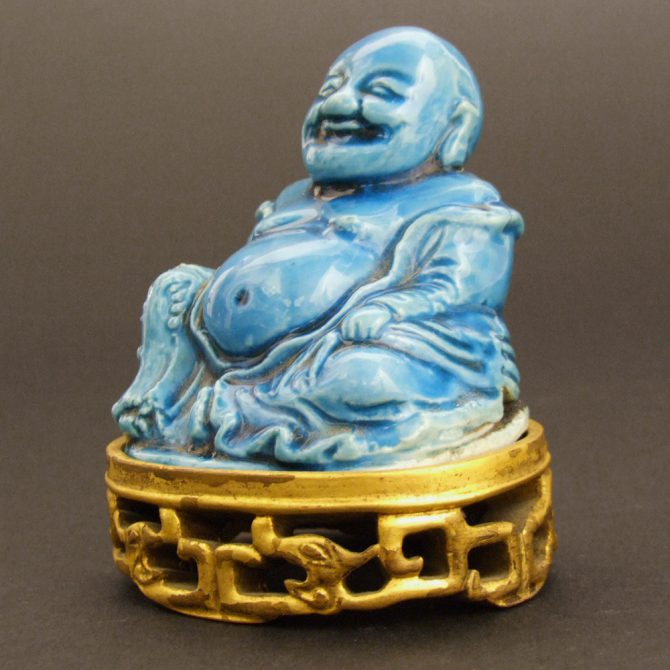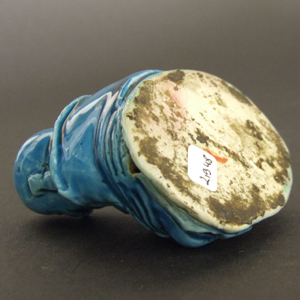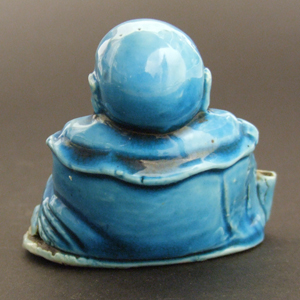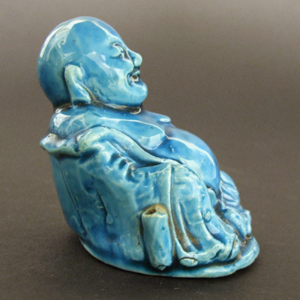
KANGXI,YONGZHENG or Early QIANLONG c.1700 – 1750 Chinese Biscuit Glazed Porcelain
An Early 18th Century Biscuit-Porcelain Turquoise Glaze Incense-Stick Holder Modelled as Budai, Late Kangxi or Yongzheng c.1700-1730.
SOLD
- Condition
- Perfect.
- Size
- Height : 6.2 cm (2 1/2 inches).
- Provenance
- From a Private American Collection of 18th century biscuit porcelain figures.
- Stock number
- 21948
- References
- For a group of 18th century turquoise porcelain models of Budai with French ormolu mounts see : Fine Chinese Export Ceramics and Works of Art, Christie`s London 1st November 1993, lots 42 and 43. and a further pair of 18th century turquoise porcelain models of Budai see : Importante Collection de la Compagnie des Indes et Porcelaine de Chine, Sotheby Park Bernet Monaco S.A., 9 February 1981, lot 920. For two seated Chinese figures of this model mounted in Germany as candlesticks in c.1740-1750 see : Chinese Export Ceramics (Rose Kerr, Luisa Mengoni, Ming Wilson, V&A Publishing 2011. ISBN 9781-85177-6320) page 91, plate 126.
Information
18th Century Turquoise Glaze :
During the early 18th century a number of monochromes glazes were developed at the Jingdezhen kilns. Alkaline leadless glazes such as turquoise which uses copper as its colouring agent were popular, the copper colouring agent was referred to as `copper powder`, essentially a mixture of copper oxide and iron-rich clay. Porcelain stone of kaolinised type was used in the glaze, the highly siliceous nature of this porcelain stone helped control but not eliminate crazing. This turquoise monochrome glaze is translucent in nature and has a highly reflective surface making its appearance very lively. It was especially sort after in France, where by the second quarter of the 18th century, blue and white feel out of favour. The French often converted their imported Chinese turquoise monochromes into French objects by the addition of ormolu (high-carat gold in a mercury amalgam used coat to bronze). Sometimes several Chinese monochrome objects were incorporated into an ormolu base or object to make something totally European. Small turquoise glazed Budai figures were especially popular as they added a whimsical oriental flavour.
Budai :
Budai (Hotei in Japanese) is a Chinese deity. His name means `Cloth Sack`, and comes from the bag that he carries. According to Chinese tradition, Budai was an eccentric Chinese Zen monk who lived during the 10th Century. He is almost always shown smiling or laughing, hence his nickname in Chinese, the Laughing Buddha. In English speaking countries, he is popularly known also as the `Fat Buddha`. Budai is often depicted as having the appearance of an amply proportioned bald man wearing a robe and wearing or otherwise carrying prayer beads. He carries his few possessions in a cloth sack, being poor but content. His figure appears throughout Chinese culture as a representation of contentment. His image graces many temples, restaurants, amulets, and businesses. Amongst Westerners new to Buddhism, Budai is often confused with the historical Buddha, Siddhartha Gautama. However, the two are visually very distinct. Gautama is commonly depicted as being tall and slender in appearance (although since no images of him from his lifetime exist, this depiction of him is unverifiable and possibly idealized); Budai is short and overweight. (Buddha means `one who has achieved a state of perfect enlightenment` and there are several people who have been given the title.)Information edited and reduced from www.http://en.wikipedia.org/wiki/Budai
Turquoise Glazed Figures of Budai :
In China porcelain figures of Budai would often have a slender incense-stick burning at the side in the nozzle provided, they would have been used in a family shrine while offering prayers but in the West they would be seen as exotic curiosities. Some were used, in a different form, as brush washers. Figures of Budai were sometimes referred to as Magot or Pagod. The term Magot was used from as early as the mid 17th century to describe the European heavy set or bizarre representations in clay, plaster, bronze or porcelain of Chinese or Indian figures. The term is usually used to describe the European porcelain. `Pagoda Figure` comes from the term pagode or religious figures housed in pagoda shrines. (Kisluk-Grosheide, `The Reign of Magots and Pagods`, Metropolitan Museum Journal 73, 2002, pp. 177, 181, 182, 184).


